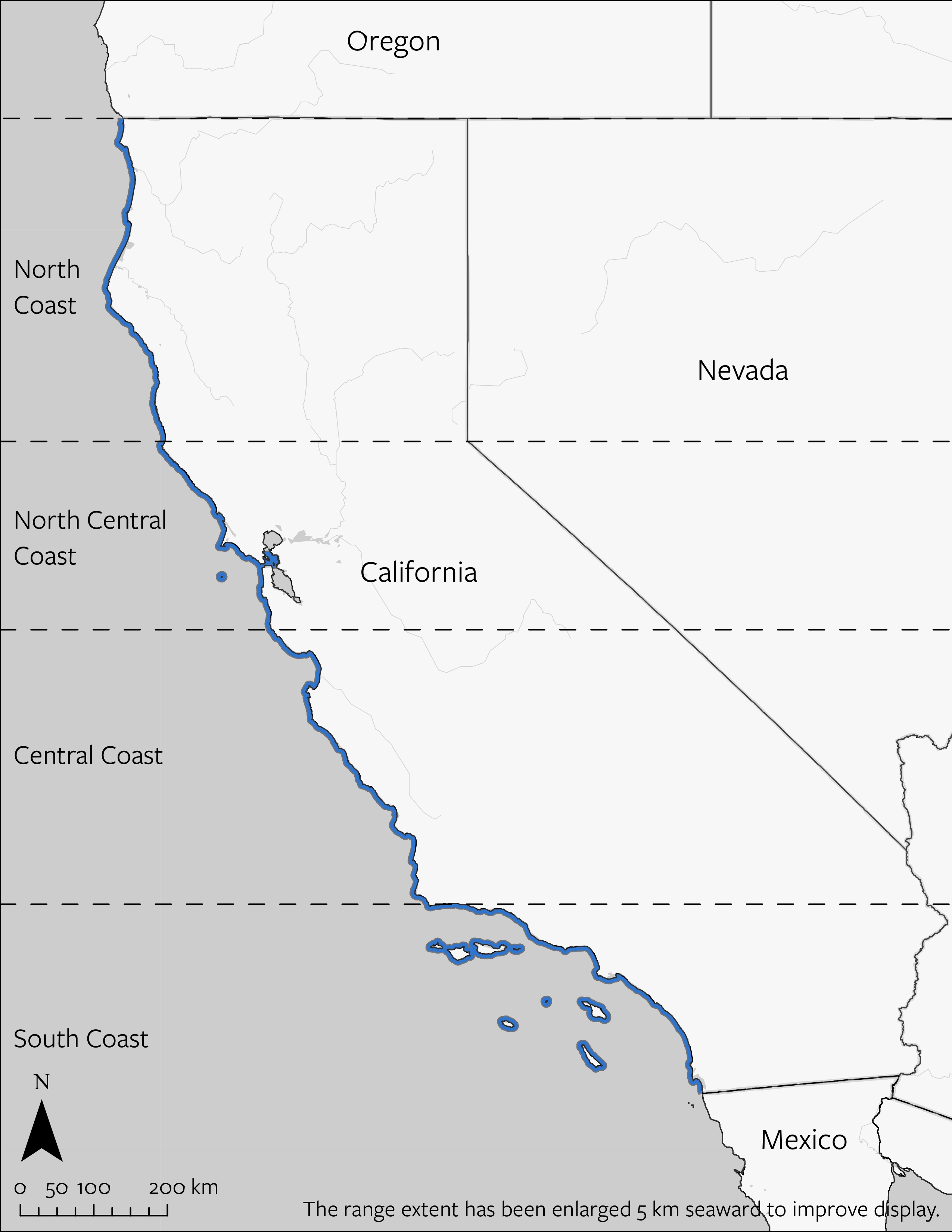California Mussel
Mytilus californianus
California Mussel
Mytilus californianus
Morphology
The California mussel is a large marine bivalve with a bluish black ribbed shell. They can grow to lengths of 13-25 centimeters and widths of 10-11.5 centimeters. They attach themselves to hard surfaces using their byssal threads. Because they grow in large dense beds, California mussels are considered habitat engineers – creating complex three-dimensional structures that provide habitat for numerous other species.
Habitat and Range
The California mussel is native to the west coast of North America, occurring from northern Mexico to Alaska. These mussels occupy mostly middle intertidal habitats which are exposed to air for shorter periods of time than the upper intertidal. They can extend subtidally to a depth of 100 meters. They prefer areas with low sediment and strong wave action. They do not colonize bare rock easily, instead preferring to settle amongst pre-existing mussels, filamentous algae, and barnacles.
Range Map

Reproductive Biology and Life History
California mussels have separate sexes with spawning occurring throughout the year at a low level, but with peak breeding times in July and December in California. Eggs and sperm are released into the water column where external fertilization takes place. Planktonic larvae go through several stages before transitioning from swimming larvae to juvenile mussels. The duration of the larval stage can range from three weeks to several months depending on temperature and availability of settling sites. Young mussels can detach and move to find more favorable substrate before reattaching.
Ecology
Mussels are often referred to as a “foundation species” because they provide shelter and food to so many other intertidal species. These mussels filter water at prodigious rates – as much as 35 to 75 liters per day per mussel – and from this water extract plankton and fine organic detritus. As filter feeders, mussels clear the water around them and regenerate nutrients that benefit algae growth, which in turn attracts more species to the community. Their feces also provide food for deposit feeders.
Cultural and Historical Context
California mussels were an important food source for coastal Native American tribes for thousands of years. Archaeological evidence shows Indigenous peoples have been harvesting and consuming these mussels for over 10,000 years. Their abundance and accessibility in intertidal zones made them a staple in the diets of coastal communities. They are still harvested for food and bait, although this is not the mussel species most often found in seafood restaurants. The flesh of the California mussel tends to be orange in color. They can be baked, boiled, or fried.
Date modified: January 2025
This animal can be found at the Aquarium of the Pacific
Primary ThreatsPrimary Threats Conditions
Threats and Conservation Status
The California mussel data from the MARINe Network reveal a population that averaged across all sites exhibits a small annual decline rate (less than 1%) since 2000. The trend of weak decline (< 1% annually) is seen in all regions, except for the South Coast region where the decline is more rapid (at 1.7% per year). The underlying cause of these slight declines in mussels warrants further research and monitoring.
Because of the prodigious amounts of water they filter, California mussels can bioaccumulate pollutants. Among the contaminants they might accumulate are polybrominated diphenyl ethers (flame retardants), pesticides, trace metals, and pharmaceutical and personal care products. In addition, ocean acidification is known to impact California mussels – it changes the composition of their shells and makes the shells thinner and more vulnerable to predation by crabs, carnivorous snails, and other predators.
As ectotherms, mussels face metabolic challenges and possible cellular damage if exposed to excessively high air and water temperatures, which are occurring more frequently with climate change. However, some laboratory experiments suggest that California mussels can acclimate to heating, which may reduce their vulnerability to heat waves. Heat is not the only stress they face. The combination of ocean acidification, changes in plankton composition and abundance, layered on top of hotter air and water temperatures might well combine to present a multistressor environment to California mussels in ways that reduce their ability to adapt to one stressor at a time. While California mussels are still so abundant that they do not warrant conservation action, they should be monitored as potential harbingers of environmental impacts to come in the future.
Population Plots






Data Source: The data were obtained from the rocky intertidal sampling locations that are part of the MARINe Network (see https://marine.ucsc.edu/). The MARINe website describes the sampling protocol.

